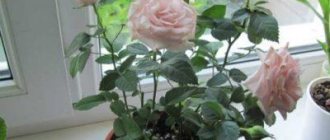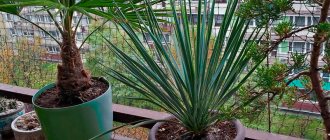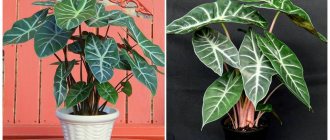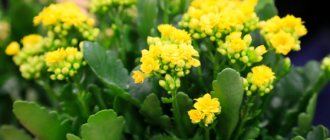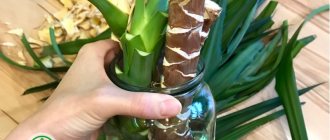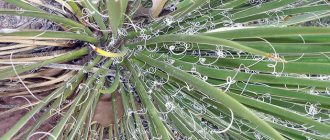The false palm Yucca Elephantis or elephant palm, a member of the Agave family, can grow well in hot, dry climates. Fans of large plants successfully grow yucca at home as an indoor flower, periodically creating humid, subtropical-like conditions.
Ropes have been woven from yucca fibers since ancient times; their strength is not inferior to steel cables; make paper. The first denim fabric was obtained from its fibers. People popularly prepare “culinary masterpieces” from the buds, fruits and young leaves of the plant, as well as remedies for the treatment of the musculoskeletal system, gastrointestinal tract, inflammation, prostatitis and other diseases. Astrologers believe that yucca is a tree of happiness, capable of improving the home atmosphere with its energy and neutralizing negative emotions.
What a resident of the Mexican semi-deserts, elephant yucca, is, how to care for it at home, what pests and diseases interfere with its development, we will tell you later in the article.
Types and varieties
There are many varieties of the plant that differ from each other. Yucca
leaves Thanks to them, the plant is very hardy and can grow in different conditions. Important! The botanical name of elephant yucca is Yucca elephantis.
Popular plant types:
Yucca elephantipes
This is the most common type. The flower is distinguished by its unusual trunk shape. Outwardly, it looks like an elephant's leg. In nature, the bush reaches 9 m in height . The leaves are narrow, but very large.
They grow up to 120 cm long. At home, the plant is compact and does not bloom.
Yucca filamentosa
The flower's homeland is Texas. The plant is unpretentious and tolerates low temperatures and drought.
Yucca aloelia Marginata
The plant is found in Mexico and the USA. Yucca is presented in the form of a bush. The stem is underdeveloped. Mature plants reach 8 m in height . Externally, the flower is very similar to scarlet, which is why it got its name.
Each leaf has a splint that makes the plant prickly. The plates are long and bright. They do not fall off like other species, but wither and bend down, covering the stem.
In nature, this species blooms. The peduncle reaches 0.5 m in height. Inflorescences are white and purple. Each open bud reaches 3 cm in length.
Yucca glauca
This species is often called bear grass or Spanish bayonet. This is an evergreen flower that has hard foliage plates of a bluish or green-blue hue. The bush grows up to 2 m tall.
The leaves are long, up to 60 cm long. Fibers are visible at the edges, entangling the plates with each other. The peduncle reaches 1 m in height. The flowers are small. They may be white or greenish.
Important! Yucca filamentosa is the species most suitable for cultivation in the Middle East and Europe.
Description
The false palm of this species has a lignified trunk , which in adult plants looks like a giant elephant's foot; it is because of this similarity that the yucca received the name Elephant's Foot. The leaves are about a meter long, pointed in shape, hard, collected in a rosette at the base. The color of the leaves is light green.
The plant is large in size , so it is most often grown in spacious rooms. Looks good both in composition with various indoor flowers and alone.
Increasingly, you can find this exotic plant among other common flowers in gardens and apartments. On our website in a number of publications you can get acquainted with the elegant garden yucca, the original bluish yucca, the heat-loving aloel foliage, and the beautiful filamentosa yucca.
Home care
Yucca elephant does not require special care. In order for a flower to be attractive and bright, it is enough to adhere to the rules of watering, air temperature, and lighting.
Lighting
The plant develops best in a room with diffused light. A good place are windows that face east or west.
Important! In winter, it is recommended to highlight the flower. To do this, install phyto-lamps near the flowerpot. They should be placed half a meter from the leaf plates. It is necessary to keep the lamps on for at least 6 hours a day.
In the summer, the plant should be exposed to fresh air. This could be a balcony or terrace.
Temperature
During the hot season, yucca should be kept at a temperature of about +220C . In winter, the thermometer readings drop to +150C. The flowerpot must not be placed near heating appliances or under the air conditioner.
Advice! When growing yucca at home, you should remember that the plant does not react well to sudden changes in temperature. This may cause the flower to begin to lose its attractiveness.
Air humidity
If you want the bush to have an attractive appearance, then you need to provide it with appropriate air humidity.
To do this, in the hot months, place a tray with water and pebbles near the flowerpot. also recommended to systematically wipe the leaves with a damp cloth. It is not necessary to spray the flower.
How to water
A lot depends on proper irrigation. In summer, the procedure is carried out every two to three days. In winter, watering is reduced, otherwise the root system will begin to rot . Water should only be used well-settled and at room temperature.
This video shows Yucca and tells you how to care for the tree-like plant.
Flowering period
All types of yucca are capable of blooming, but at home it is almost impossible to see colorful inflorescences. In order for the buds to form, the plant must be provided with a long wintering period.
Feeding fertilizers
This is a very important procedure. They begin to fertilize in early spring and until the end of summer. are applied once every 20 days. To do this, use mullein infusion or special mineral complexes.
How to replant a false palm
When transplanting yucca, you need to pay special attention to the choice of soil. It is best to use nutrient soil. You can either buy it or prepare it yourself.
The container should be deep. It is necessary to lay a layer of drainage at the bottom of the flowerpot, the thickness of which should be within 5 cm.
Before planting, the roots of the plant will need to be completely freed from soil . To do this, place the yucca in a bucket of water for a day.
This video shows how to properly transplant Yucca.
Watering and fertilizing
The plant requires moderate watering in the summer.
Even in hot weather, it should not be watered more than once a week. Yucca, like other inhabitants of dry areas, needs to be watered so that the entire earthen ball is well moistened. After this, the plant is not watered until almost all the soil in the pot is dry. In winter, at low temperatures, watering yucca is greatly reduced .
Water no more than once a month. It should be remembered that even slight stagnation of cold water leads to the death of the plant. The soil in which yucca grows is fertilized only during the growing season of the plant from the beginning of May to the end of September. To do this, you can use liquid complex fertilizers for palm trees and succulents.
You can also use universal mineral fertilizers for deciduous plants. Yucca is fed monthly; fertilizers are applied to moist soil 3-4 hours after watering.
During the dormant period, yucca is not fed.
How to prune yucca
Since Yucca elephantis grows very tall, it requires pruning at home. The procedure should be carried out as the plant grows. Trim the top of the bush.
This should only be done with sharp garden shears or pruning shears. Thanks to this, new shoots will appear on the stem, which will give the bush an attractive appearance.
Useful properties of yucca
Yucca elephant indoors.
Photo Fibers from yucca, which grows naturally, are used for technical purposes to make denim fabrics durable. It is used as a dietary supplement in cosmetology. In folk medicine, healing and bactericidal properties are used.
Home plant species create coziness, a peaceful atmosphere, help purify the air and absorb noise. It is believed that peace and prosperity reign in a house where yucca grows. In office buildings, the mysterious flower is grown for good luck in business.
Reproduction of elephant yucca
Growing a new young plant at home is not that difficult. There are several ways to do this. All of them are effective, the main thing is to adhere to some rules.
Seed method
To sow seeds, use only light and nutritious soil. It can be prepared from sand, deciduous and turf soil . Before planting grains, the soil is well irrigated.
Yucca should be sown at a shallow depth. To make the seeds germinate faster, it is recommended to cover the top of the container with transparent glass or polyethylene. A month after germination, the seedlings can be transplanted into separate pots.
Reproduction of yucca by shoots
This method is often used by gardeners. To do this, the lateral processes are separated and placed in wet sand. After the roots appear, the seedlings can be moved to separate containers .
This video shows one of the ways to propagate Yucca by shoots.
Cuttings
Planting material should be about 10 cm long. All separated parts are placed in a substrate of sand and soil. Each cutting is covered with a bottle or jar.
After the first leaves appear at the cutting sites, the cuttings are removed and the shoots are separated. Young specimens are planted in breathable soil.
Diseases and pests
Like most indoor decorative flowers, yucca often suffers from insects. It can be affected by scale insects, thrips, mealybugs, aphids, leaf beetles, and caterpillars . Fight such insects with soapy water or insecticides.
Leaves are drying
If the leaf blades of the plant begin to change color and dry out, then a sign of this may be a lack of sunlight. And also changes occur when exposed to direct sunlight . In this case, the flowerpot should be moved to a room whose windows face the west or east.
The leaves are turning yellow
A sign may be either excess moisture or the use of cold water. Also, the leaves turn yellow with sudden changes in temperature.
Yucca elephant is a unique plant that, with proper care, will decorate any room. To achieve the desired result, you just need to follow simple growing rules.
This video shows Yucca pruning and one of the methods for replanting it, and also talks about the propagation of the tree.
Possible difficulties during cultivation
When cultivating yucca, you can encounter harmful insects and diseases, the cause of which is improperly created conditions.
The following insects are harmful to this species:
- thrips;
- caterpillars;
- spider mite;
- scale insect;
- aphid.
To combat them, insecticides and soap solution are used.
Important! If the lower leaves of elephant yucca turn yellow and dry out, this is
mostly a natural process when a mature plant gets rid of the lower part of the foliage.
The presence of problems is indicated by yellowing of the foliage at the top of the crown or at the tips. The following diseases cause great harm to palm trees:
- stem rot;
- botrytis mushroom;
- bacterial burn;
- brown spotting;
- gray spotting;
- root rot.
It is difficult to resist diseases, but fungicides and removal of rotten areas can help. Usually, a sick representative of the species has to be thrown out along with the soil. Thus, elephant yucca can decorate any room with minimal effort spent on its cultivation. In warm climates, it can be kept outside, then the false palm can bloom.



